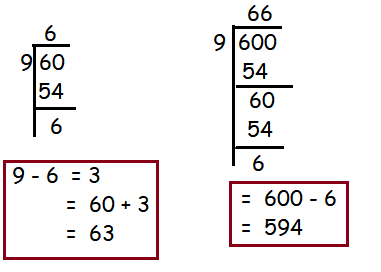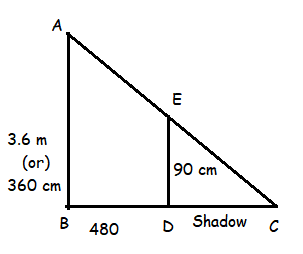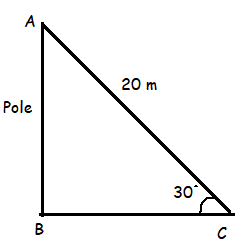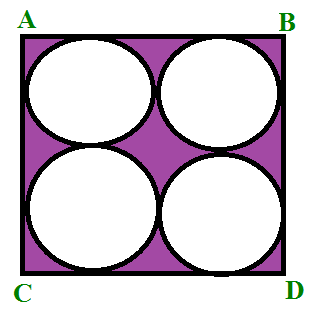10th GRADE MATH PRACTICE QUESTIONS WITH SOLUTION
Problem 1 :
Find the number of integers between 60 and 600 which are divisible by 9.
Solution :

Terms which are divisible by 9 between 60 and 600.
63, 72, 81, ........ 594
n = [ (l - a)/d ] + 1
n = [(594 - 63)/9] + 1
n = (531/9) + 1
n = 59 + 1
n = 60
So, the number of terms divisible by 9 between 60 and 600 is 60.
Problem 2 :
The sum of a two digit number and the number obtained by reversing the digits is 66. If the digits of the number differs by 2, find the number.
Solution :
Let xy be the required two digit number.
xy + yx = 66
10x + y + 10y + x = 66
11x + 11y = 66
Dividing it by 11, we get
x + y = 6 -----(1)
x - y = 2 -----(2)
(1) + (2)
2x = 8
x = 4
By applying the value of x in (2), we get
4 - y = 2
y = 4 - 2
y = 2
So the required two digit number is 42.
Problem 3 :
Find two consecutive odd positive integers, sum of their squares is 290.
Solution :
Let x and x + 2 are two consecutive numbers.
x2 + (x + 2)2 = 290
x2 + x2 + 4x + 4 = 290
2x2 + 4x - 286 = 0
Dividing the entire equation by 2, we get
x2 + 2x - 143 = 0
(x + 13) (x - 11) = 0
x = -13 or x = 11
So, the two consecutive odd numbers are 11 and 13.
Problem 4 :
A boy of height 90 cm is walking away from the base of a lamp-post at a speed of 1.2 m/s.The lamp is 3.6 m above the ground level, find the length of her shadow after 4 seconds.
Solution :

Two triangles, ABC and EDC are similar.
AB/DE = BD/DC
360 / 90 = (480 + DC) / DC
4 DC = 480 + DC
3DC = 480
DC = 160
DC = 1.6 m
So, the length of shadow after 4 seconds is 1.6 m.
Problem 5 :
If the points A (4, 6), B(10, 4), C(8, 2) and D(b, 4) are the vertices of a parallelogram taken in order, find the value of b.
Solution :
Midpoint of diagonal AC = Midpoint of diagonal BD
Midpoint = (x1 + x2)/2, (y1 + y2)/2
(4 + 8)/2, (6 + 2)/2 = (10+b)/2, (4 + 4)/2
12/2, 8/2 = (10+b)/2, 8/2
(6, 4) = ((10+b)/2, 4)
Equating x coordinates,
6 = (10 + b)/2
12 = 10 + b
b = 12 - 10
b = 2
So, the value of b is 2.
Problem 6 :
A circus artist is climbing a 20 m long rope, which is stretched and tied from the top of a vertical pole to the ground.Calculate the height of the pole, if the angle created by the rope with the ground level is 30°.
Solution :

AB - height of pole, AC - length of rope, BC - horizontal distance between pole and the point C.
sin θ = AB/AC
sin 30 = AB/20
1/2 = AB/20
AB = 20/2
AB = 10
So, height of the pole is 10 m.
Problem 7 :
A farmer wishes to start a 100 sq.m rectangular garden. Since he has only 30 m barbed wire, he fences the sides of a rectangular garden getting letting his house compound wall act as the fourth side fence. Determine the dimension of the garden.
Solution :
Area of rectangular garden = 100 sq.m
Let x be the length and y be the width of the rectangular wall.
Quantity of wire to be used for fencing = 30 m
2x + y = 30
y = 30 - 2x -----(1)
xy = 100 ----(2)
x(30 - 2x) = 100
30x - 2x2 = 100
Divide it by 5, we get
x2 - 15x + 50 = 0
(x - 10) (x - 5) = 0
x - 10 = 0 and x - 5 = 0
x = 10 and x = 5
Problem 8 :
Find the area of the shaded portion in the below figure, where ABCD is a square of side 14 cm.

Solution :
Side length of square is 14 cm.
Diameter of each circle = 7 cm
radius = 7/2
Area of circle = πr2
= (22/7) ⋅ (7/2)2
Area of 4 circles = 4 ⋅ (22/7) ⋅ (7/2)2
= 154
Area of square = 142 = 196
Area of shaded region = 196 - 154
= 42 cm2
Area of the shaded region is 42 cm2.
Problem 9 :
Find the centroid of the triangle whose vertices are the points (8, 4) (1, 3) and (3, -1).
Solution :
Centroid of the triangle
= (x1+x2+x3)/3, (y1+y2+y3)/3
= (8+1+3)/3, (4+3-1)/3
= 12/3, 6/3
= (4, 2)
So, centroid of the given triangle is (4, 2).
Problem 10 :
The standard deviation and the mean of 20 values are 21.2 and 36.6.Find the coefficient of variation.
Solution :
Standard deviation (σ) = 21.2
Mean (x̅) = 36.6
Coefficient of variation = (σ/x̅) ⋅ 100%
= (21.2/36.6) ⋅ 100%
= 0.579 ⋅ 100%
= 57.9
So, the coefficient of variation is 57.9.
Kindly mail your feedback to v4formath@gmail.com
We always appreciate your feedback.
©All rights reserved. onlinemath4all.com
Recent Articles
-
Digital SAT Math Problems and Solutions (Part - 146)
Apr 18, 25 06:52 AM
Digital SAT Math Problems and Solutions (Part - 146) -
Logarithmic Derivative Problems and Solutions
Apr 16, 25 09:25 PM
Logarithmic Derivative Problems and Solutions -
Digital SAT Math Problems and Solutions (Part - 145)
Apr 16, 25 12:35 PM
Digital SAT Math Problems and Solutions (Part - 145)

